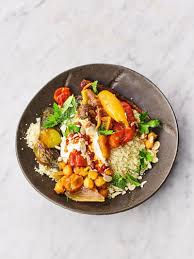The Art of Tagine: A Culinary Journey Through Morocco
Tagine, a traditional North African dish named after the clay pot in which it is cooked, is a culinary masterpiece that embodies the essence of Moroccan cuisine. This iconic dish has captured the hearts and taste buds of food enthusiasts around the world.
Origins and History
The tagine pot, with its distinctive conical lid, dates back centuries and is believed to have originated in Morocco. Its design allows for slow cooking at low temperatures, resulting in tender meat and perfectly infused flavours.
Ingredients and Flavours
A typical tagine consists of succulent meat – often lamb or chicken – paired with an array of spices such as cumin, cinnamon, turmeric, and saffron. Vegetables like carrots, potatoes, and olives are also commonly included to add depth and texture to the dish.
Cooking Technique
To prepare a tagine, ingredients are layered in the pot and slow-cooked over low heat. The conical lid helps trap steam, allowing the flavours to meld together harmoniously. The result is a tender and aromatic stew that tantalises the senses.
Serving and Enjoyment
Tagine is traditionally served family-style with couscous or crusty bread for soaking up the delicious sauce. The communal dining experience encourages sharing and conviviality, making every meal an occasion to remember.
Global Appeal
Due to its exotic flavours and vibrant presentation, tagine has gained popularity worldwide. From bustling restaurants in Marrakech to home kitchens in London, this dish continues to captivate food lovers seeking a taste of Moroccan culture.
Experience Tagine Yourself
Embark on your own culinary adventure by trying your hand at preparing a tagine dish. Explore different recipes, experiment with spices, and savour the rich aromas that fill your kitchen as you recreate this Moroccan classic.
7 Advantages of Cooking with a Tagine: From Tender Meat to Global Appeal
- 1. Tender and flavourful meat
- 2. Rich and aromatic sauces
- 3. Versatile dish
- 4. Healthy cooking
- 5. Beautiful presentation
- 6. Communal dining experience
- 7. Global appeal
Challenges of Cooking with a Tagine: What to Consider
- Long cooking time
- Specialized cookware
- Limited capacity
- Risk of burning
- May require unique ingredients
- Not suitable for all diets
1. Tender and flavourful meat
The tagine cooking method is renowned for its ability to produce exquisitely tender and flavourful meat. Through slow cooking at low temperatures in the iconic clay pot, the meat emerges succulent and infused with a symphony of aromatic spices. This meticulous process ensures that each bite of tagine offers a melt-in-your-mouth experience, showcasing the harmonious marriage of textures and flavours that define this beloved Moroccan dish.
2. Rich and aromatic sauces
Indulge in the tantalising allure of tagine’s rich and aromatic sauces, a delightful pro that emerges from the slow cooking process. As the ingredients simmer gently within the clay pot, their essences intertwine harmoniously, resulting in sauces that are not just flavourful but truly decadent. Each spoonful of these velvety concoctions promises a burst of complex flavours that reflect the essence of Moroccan cuisine, making every bite a culinary journey worth savouring.
3. Versatile dish
Tagine’s versatility shines through as it allows for the incorporation of a wide range of meats, vegetables, and spices, opening up a world of culinary creativity. Whether prepared with succulent lamb, tender chicken, or even vegetarian options, combined with an array of vibrant vegetables and aromatic spices, tagine offers endless possibilities to tailor the dish to individual preferences and experiment with diverse flavour combinations. This flexibility makes tagine a truly adaptable and exciting dish that can cater to different tastes and dietary requirements while still retaining its authentic Moroccan essence.
4. Healthy cooking
Slow cooking in a tagine pot offers a significant health benefit by preserving nutrients and flavours while requiring minimal oil or fat. The gentle cooking process allows ingredients to simmer and meld together, resulting in a nutrient-rich and flavourful dish without the need for excessive added fats. This makes tagine an excellent choice for those looking to enjoy delicious meals while maintaining a healthy lifestyle.
5. Beautiful presentation
The beautiful presentation of a tagine is truly a sight to behold. The iconic conical lid of the tagine pot adds an exotic touch to your dining table, transforming any meal into a visual masterpiece. Its unique design not only enhances the flavours of the dish but also creates a feast for the eyes, elevating the dining experience to a whole new level of elegance and charm.
6. Communal dining experience
Serving tagine family-style fosters a communal dining experience that goes beyond just sharing a meal. It creates an opportunity for bonding and connection as loved ones gather around the table to enjoy the rich flavours and aromas of this traditional dish. The act of passing around the tagine pot, scooping up tender meat and vegetables, and savouring each bite together enhances the sense of togetherness and camaraderie, making every dining occasion a memorable and heartwarming experience.
7. Global appeal
Tagine’s global appeal lies in its ability to enchant food enthusiasts from diverse cultures around the world. The dish’s exotic flavours and aromatic spices have transcended borders, establishing it as a beloved choice in international cuisine. Whether enjoyed in a bustling Moroccan marketplace or a trendy restaurant in a cosmopolitan city, tagine continues to charm diners with its rich heritage and tantalising taste profile.
Long cooking time
Tagine dishes, while renowned for their rich flavours and tender textures, come with the con of a long cooking time. The slow-cooking process, often spanning several hours, may pose a challenge for individuals seeking quick and convenient meal preparation. This extended cooking duration demands patience and advance planning, making tagine more suited for leisurely weekend cooking sessions or special occasions where the luxurious taste of slow-cooked dishes can be savoured at a relaxed pace.
Specialized cookware
Cooking a tagine traditionally presents a challenge due to the need for specialized cookware – a clay pot designed specifically for this dish. This unique cooking vessel may not be easily accessible in every kitchen, limiting the ability of home cooks to replicate the authentic tagine experience. The absence of this traditional pot can impact the cooking process and potentially alter the final taste and texture of the dish, highlighting the importance of using the right tools to honour the culinary heritage of Morocco.
Limited capacity
The conical shape of the tagine pot, while iconic and traditional, presents a limitation in terms of capacity. This unique design may restrict the quantity of food that can be prepared in a single batch, posing a challenge for larger gatherings or when cooking for a crowd. As such, those looking to serve a substantial number of guests may find it cumbersome to prepare multiple tagine pots simultaneously to accommodate everyone’s appetite.
Risk of burning
When preparing tagine, one must be cautious of the risk of burning or sticking due to the low and indirect heat involved in the cooking process. Without close monitoring, the delicate balance of flavours and textures in the dish may be compromised, highlighting the importance of attentive cooking to achieve the perfect tagine experience.
May require unique ingredients
Some tagine recipes may pose a challenge as they call for spices or ingredients that are not readily available in standard grocery stores. This can add an element of complexity to the cooking process, necessitating extra effort to locate these unique components. However, the quest for these special ingredients is often rewarded with an authentic and flavourful tagine that truly captures the essence of Moroccan cuisine.
Not suitable for all diets
Traditional tagine recipes predominantly centre around meat as the primary component, which may pose a challenge for individuals following vegetarian or vegan diets. The rich flavours and textures that characterise tagine are often derived from the slow-cooked meats and their juices, limiting the dish’s inclusivity for those seeking plant-based alternatives. As such, individuals with dietary restrictions or preferences may need to explore creative adaptations or alternative recipes to fully experience the essence of this iconic Moroccan dish.




